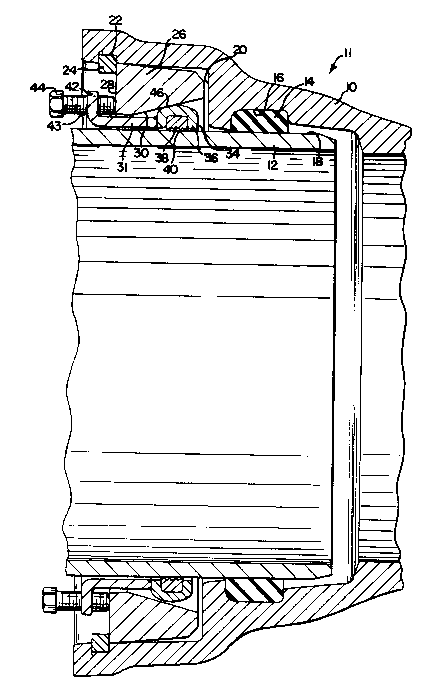Une partie des informations de ce site Web a été fournie par des sources externes. Le gouvernement du Canada n'assume aucune responsabilité concernant la précision, l'actualité ou la fiabilité des informations fournies par les sources externes. Les utilisateurs qui désirent employer cette information devraient consulter directement la source des informations. Le contenu fourni par les sources externes n'est pas assujetti aux exigences sur les langues officielles, la protection des renseignements personnels et l'accessibilité.
L'apparition de différences dans le texte et l'image des Revendications et de l'Abrégé dépend du moment auquel le document est publié. Les textes des Revendications et de l'Abrégé sont affichés :
| (12) Brevet: | (11) CA 2036785 |
|---|---|
| (54) Titre français: | JOINT MECANIQUE DE RETENUE DE TUYAU |
| (54) Titre anglais: | RESTRAINED PIPE JOINT |
| Statut: | Périmé et au-delà du délai pour l’annulation |
| (51) Classification internationale des brevets (CIB): |
|
|---|---|
| (72) Inventeurs : |
|
| (73) Titulaires : |
|
| (71) Demandeurs : |
|
| (74) Agent: | BORDEN LADNER GERVAIS LLP |
| (74) Co-agent: | |
| (45) Délivré: | 1996-08-13 |
| (22) Date de dépôt: | 1991-02-21 |
| (41) Mise à la disponibilité du public: | 1991-11-03 |
| Requête d'examen: | 1991-02-21 |
| Licence disponible: | S.O. |
| Cédé au domaine public: | S.O. |
| (25) Langue des documents déposés: | Anglais |
| Traité de coopération en matière de brevets (PCT): | Non |
|---|
| (30) Données de priorité de la demande: | ||||||
|---|---|---|---|---|---|---|
|
A restrained pipe joint is provided for affixing the spigot
end of a first pipe into the socket end of a second pipe. The
pipe joint includes a circular restraining ring and a retainer
ring which includes a groove ring and a plurality of locking
segments. When the retaining ring is tightened, the retaining
ring is forced against the circular restraining ring, thereby
engaging the locking segment teeth into the spigot end of the
first pipe. The groove ring abuts the circular restraining ring
which holds the spigot end of the first pipe within the socket
end of the second pipe.
Note : Les revendications sont présentées dans la langue officielle dans laquelle elles ont été soumises.
Note : Les descriptions sont présentées dans la langue officielle dans laquelle elles ont été soumises.

2024-08-01 : Dans le cadre de la transition vers les Brevets de nouvelle génération (BNG), la base de données sur les brevets canadiens (BDBC) contient désormais un Historique d'événement plus détaillé, qui reproduit le Journal des événements de notre nouvelle solution interne.
Veuillez noter que les événements débutant par « Inactive : » se réfèrent à des événements qui ne sont plus utilisés dans notre nouvelle solution interne.
Pour une meilleure compréhension de l'état de la demande ou brevet qui figure sur cette page, la rubrique Mise en garde , et les descriptions de Brevet , Historique d'événement , Taxes périodiques et Historique des paiements devraient être consultées.
| Description | Date |
|---|---|
| Inactive : CIB de MCD | 2006-03-11 |
| Le délai pour l'annulation est expiré | 2004-02-23 |
| Lettre envoyée | 2003-02-21 |
| Accordé par délivrance | 1996-08-13 |
| Demande publiée (accessible au public) | 1991-11-03 |
| Toutes les exigences pour l'examen - jugée conforme | 1991-02-21 |
| Exigences pour une requête d'examen - jugée conforme | 1991-02-21 |
Il n'y a pas d'historique d'abandonnement
| Type de taxes | Anniversaire | Échéance | Date payée |
|---|---|---|---|
| TM (brevet, 7e anniv.) - générale | 1998-02-23 | 1998-02-04 | |
| TM (brevet, 8e anniv.) - générale | 1999-02-22 | 1999-02-10 | |
| TM (brevet, 9e anniv.) - générale | 2000-02-21 | 2000-02-02 | |
| TM (brevet, 10e anniv.) - générale | 2001-02-21 | 2001-02-01 | |
| TM (brevet, 11e anniv.) - générale | 2002-02-21 | 2002-01-31 |
Les titulaires actuels et antérieures au dossier sont affichés en ordre alphabétique.
| Titulaires actuels au dossier |
|---|
| AMSTED INDUSTRIES INCORPORATED |
| Titulaires antérieures au dossier |
|---|
| JOHN J. BUDZIAK |
| ROBERT G. PETING |